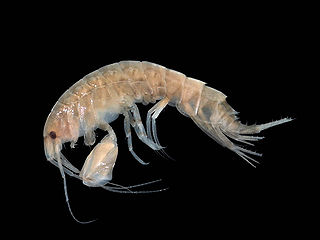The Permian is a geologic period and system which spans 47 million years from the end of the Carboniferous period 298.9 million years ago (Mya), to the beginning of the Triassic period 251.902 Mya. It is the last period of the Paleozoic era; the following Triassic period belongs to the Mesozoic era. The concept of the Permian was introduced in 1841 by geologist Sir Roderick Murchison, who named it after the region of Perm in Russia.

The gastropods, more commonly known as snails and slugs, belong to a large taxonomic class of invertebrates within the phylum Mollusca, called Gastropoda. This class comprises snails and slugs from saltwater, from freshwater, and from the land. There are many thousands of species of sea snails and slugs, as well as freshwater snails, freshwater limpets, and land snails and slugs.

Goniatids, informally Goniatites, are ammonoid cephalopods that form the order Goniatitida, derived from the more primitive Agoniatitida during the Middle Devonian some 390 million years ago. Goniatites (goniatitids) survived the Late Devonian extinction to flourish during the Carboniferous and Permian only to become extinct at the end of the Permian some 139 million years later.
Hunnebergia is an extinct genus from a well-known class of fossil marine arthropods, the trilobites. It lived during the early part of the Arenig stage of the Ordovician Period, a faunal stage which lasted from approximately 478 to 471 million years ago.
Leptochilodiscus is an extinct genus from a well-known class of fossil marine arthropods, the trilobites. It lived during the Botomian stage, which lasted from approximately 524 to 518.5 million years ago. This faunal stage was part of the Cambrian Period.
Atdabanella is an extinct genus from a well-known class of fossil marine arthropods, the trilobites. It lived during the early part of the Botomian stage, which lasted from approximately 524 to 518.5 million years ago. This faunal stage was part of the Cambrian Period.
Poliellina is an extinct genus from a well-known class of fossil marine arthropods, the trilobites. It lived during the early part of the Botomian stage, which lasted from approximately 524 to 518.5 million years ago. This faunal stage was part of the Cambrian Period.
Malykania is an extinct genus from a well-known class of fossil marine arthropods, the trilobites. It lived during the early part of the Botomian stage, which lasted from approximately 524 to 518.5 million years ago. This faunal stage was part of the Cambrian Period.
Wutingaspis is an extinct genus from a well-known class of fossil marine arthropods, the trilobites. It lived during the early part of the Botomian stage, which lasted from approximately 524 to 518.5 million years ago. This faunal stage was part of the Cambrian Period.
Metaredlichia is an extinct genus from a well-known class of fossil marine arthropods, the trilobites. It lived during the early part of the Botomian stage, which lasted from approximately 524 to 518.5 million years ago. This faunal stage was part of the Cambrian Period.
Miranella is an extinct genus from a well-known class of fossil marine arthropods, the trilobites. It lived during the early part of the Botomian stage, which lasted from approximately 524 to 518.5 million years ago. This faunal stage was part of the Cambrian Period.
Kuanyangia is an extinct genus from a well-known class of fossil marine arthropods, the trilobites. It lived during the early part of the Botomian stage, which lasted from approximately 524 to 518.5 million years ago. This faunal stage was part of the Cambrian Period.
Arthricocephalus is an extinct genus from a well-known class of fossil marine arthropods, the trilobites. It lived during the later part of the Botomian stage, which lasted from approximately 524 to 518.5 million years ago. This faunal stage was part of the Cambrian Period.
Runcinodiscus is an extinct genus from a well-known class of fossil marine arthropods, the trilobites. It lived during the later part of the Botomian stage, which lasted from approximately 524 to 518.5 million years ago. This faunal stage was part of the Cambrian Period.
Megapalaeolenus is an extinct genus from a well-known class of fossil marine arthropods, the trilobites. They lived during the later part of the Botomian stage, which lasted from approximately 524 to 518.5 million years ago. This faunal stage was part of the Cambrian Period.
Feilongshania is an extinct genus from a well-known class of fossil marine arthropods, the trilobites. It lived during the later part of the Botomian stage, which lasted from approximately 524 to 518.5 million years ago. This faunal stage was part of the Cambrian Period.
Mayiella is an extinct genus from a well-known class of fossil marine arthropods, the trilobites. It lived during the later part of the Botomian stage, which lasted from approximately 524 to 518.5 million years ago. This faunal stage was part of the Cambrian Period.
Megalaspidella is an extinct genus from a well-known class of fossil marine arthropods, the trilobites. It lived during the later part of the Arenig stage of the Ordovician Period, approximately 478 to 471 million years ago.

Megalaspides is an extinct genus from a well-known class of fossil marine arthropods, the trilobites. It lived during the later part of the Arenig stage of the Ordovician Period, approximately 478 to 471 million years ago.

Crustaceans form a large, diverse arthropod taxon which includes such familiar animals as crabs, lobsters, crayfish, shrimps, prawns, krill, woodlice, and barnacles. The crustacean group is usually treated as a class under subphylum Mandibulata and because of recent molecular studies it is now well accepted that the crustacean group is paraphyletic, and comprises all animals in the Pancrustacea clade other than hexapods. Some crustaceans are more closely related to insects and other hexapods than they are to certain other crustaceans.





